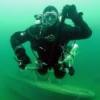This case demonstrates that correct filling procedures are essential, especially when dealing with manifolded twinsets. Even if proper checks are carried out by the diver (they seem not to have been in this case) it is not always possible to be sure what there is in each tank. As Brian (?) says, once the tanks are filled to the same pressure there will be minimal mixing through the manifold.
If poor filling techniques have been used and CO has gotten into the tank, there is in practice no way the diver can tell before going down with it. It can theoretically be detected, but those tools are not routinely available to divers. And of course CO has no taste or smell, so that doesn't help. The effect of CO on the body (as with all gases) is dependant on its partial pressure, which of course increases with depth - what is perhaps not detectable at the surface may cause a headache after a while at 20 metres, and may kill at 60 metres.
Incidentally, this highlights one reason I am so against SNUBA - the exhaust of the gasoline compressor is necessarily pretty close to the breathing air inlet, and in any conditions other than a steady moderate breeze it seems to me all too easy for fumes to be sucked into the inlet.
And of course, in an emergency at depth it is essential to be able to offer a gas that is breathable at that depth. Another reason for techies breathing from their long hoses, as the reg they're using is the one a OOA diver is most likely to grab, and it's easiest if that has a long hose so no further switching is needed.
Learning from this recent accident but going beyond it, what are people's thought on the general issues, both for yourself and someone you may encounter underwater?
And the topic title should have been "Breathing baD gas....."! Goodness knows what baG gas is. But I can't change the title.
Edited by peterbj7, 05 October 2005 - 12:50 PM.

















